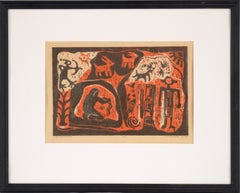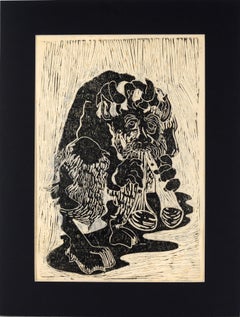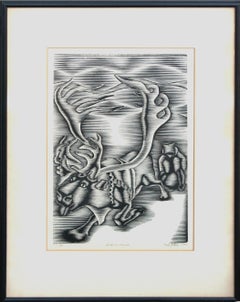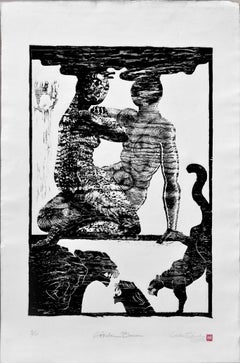Want more images or videos?
Request additional images or videos from the seller
1 of 9
UnknownComical Ukiyo-e Print with Anthropomorphic Rabbits19th century
19th century
Price:$600
About the Item
- Creation Year:19th century
- Dimensions:Height: 19 in (48.26 cm)Width: 14.5 in (36.83 cm)Depth: 1 in (2.54 cm)
- Medium:
- Movement & Style:
- Period:
- Condition:Minor tears and one hole on the margins of the paper, consistent with age. Color saturation is very good. Frame has cosmetic damage, comes as is.
- Gallery Location:Soquel, CA
- Reference Number:Seller: JMA 72911stDibs: LU54216711282
About the Seller
5.0
Platinum Seller
Premium sellers with a 4.7+ rating and 24-hour response times
Established in 1986
1stDibs seller since 2014
3,039 sales on 1stDibs
Authenticity Guarantee
In the unlikely event there’s an issue with an item’s authenticity, contact us within 1 year for a full refund. DetailsMoney-Back Guarantee
If your item is not as described, is damaged in transit, or does not arrive, contact us within 7 days for a full refund. Details24-Hour Cancellation
You have a 24-hour grace period in which to reconsider your purchase, with no questions asked.Vetted Professional Sellers
Our world-class sellers must adhere to strict standards for service and quality, maintaining the integrity of our listings.Price-Match Guarantee
If you find that a seller listed the same item for a lower price elsewhere, we’ll match it.Trusted Global Delivery
Our best-in-class carrier network provides specialized shipping options worldwide, including custom delivery.You May Also Like
Black Horse
By Tokuriki Tomikichiro
Located in Middletown, NY
circa 1950.
Woodblock print in black and gray ink on Japon laid paper, 10 1/4 x 15 3/4 inches (260 x 398 mm), full margins. With the artist's embossed chop mark in red ink in the l...
Category
Mid-20th Century Edo Animal Prints
Materials
Handmade Paper, Woodcut
Miguel's Ducky Plucky Daydreams, face, ducks, patterns, earth tones and blue
By Jenny Toth
Located in Brooklyn, NY
This is a unique mono print made with different colored inks. The image is 10x8 inches and the paper it is printed on is 16x14 inches. The images is of a young man lying down, dayd...
Category
2010s Modern Figurative Prints
Materials
Paper, Ink, Archival Ink, Woodcut
$675
H 16 in W 14 in D 0.25 in
"Drawing class: first day", 2007 Mexican humor original woodcut conceptual art
By Fernando Aceves Humana
Located in Miami, FL
Fernando Aceves Humana (Mexico, 1969)
'Clase de dibujo primer día', 2007
woodcut on paper
17.8 x 22.5 in. (45 x 57 cm.)
Edition of 20
ID: ACE-102
Unframed
Category
Early 2000s Contemporary Animal Prints
Materials
Paper, Woodcut, Ink
Jose Bedia Original Signed 2019 Large 46x78in Woodcut Serigraph Cuban Artist
By Jose Bedia
Located in Miami, FL
Jose Bedia (Cuban, 1959)
'Animal Armado', 2019. Woodcut and serigraph. Limited edition of 30
Overall size: 118 x 199 cm. (46.5 x 78.3 in.). Surface: Feltmark Paper 300 g.
Hand-signed...
Category
2010s Contemporary Animal Prints
Materials
Screen, Woodcut, Ink
Midnight Wolf: A Limited Edition Clarence Mills Signed Haida Inuit Print
Located in Alamo, CA
"Midnight Wolf" is a framed signed limited edition abstract inuit native people's work by Northwest Coast Haida artist Clarence Mills. The print depicts a st...
Category
Late 20th Century Abstract Animal Prints
Materials
Woodcut
$860 Sale Price
20% Off
H 26.88 in W 20.63 in D 0.88 in
Wings. 1975., Woodcut, 70x50 cm
By Dainis Rozkalns
Located in Riga, LV
Wings. 1975., Woodcut, 70x50 cm
Dainis Rozkalns (1928 - 2018)
Artist, graphic artist, illustrator of folklore and fiction publications. The main directions of Rožkalns' professiona...
Category
1970s Abstract Geometric Animal Prints
Materials
Paper, Woodcut
$575 Sale Price
50% Off
H 27.56 in W 19.69 in D 0.04 in
Rockwell Kent, Four Bookplates (on one sheet)
By Rockwell Kent
Located in New York, NY
Proof sheet with four wood engraved book plates by Rockwell Kent. Possibly for a book on this subject published in 1937. There are pencil numbers under each image that probably indic...
Category
Early 20th Century Art Deco Figurative Prints
Materials
Woodcut
Dan Burne Jones, Affection
Located in New York, NY
Dan Burne Jones is widely know as the author of the Rockwell Kent print catalogue raisonne. It's so interesting to see that he is a gifted wood engraver as well. Jones's own prints a...
Category
1930s American Modern Animal Prints
Materials
Woodcut
Wassily Kandinsky - Composition - Woodcut
By Wassily Kandinsky
Located in Collonge Bellerive, Geneve, CH
Wassily Kandinsky - Composition - Original Woodcut
Condition: excellent
32 x 24 cm
1959
Published by XXe siècle, San Lazzaro
Printed signature (monogram) in the plate
Unnumbered as i...
Category
1960s Abstract Geometric Animal Prints
Materials
Woodcut
Sergio Hernandez, Circus, 2010. Large woodcut 49x78 in limited edition (video)
By Sergio Hernández
Located in Miami, FL
Sergio Hernández (Mexico, 1957)
'El Circo' (Circus), 2010
woodcut on paper Velin Arches 300 g.
45.7 x 78 in. (116 x 198 cm.)
Edition of 40
Unframed
Category
2010s Contemporary Figurative Prints
Materials
Woodcut
More From This Seller
View All"The Engraver" Double Layer Woodblock Print
Located in Soquel, CA
Bold woodcut print by M. Sheppard (20th Century). This piece is filled with Neolithic imagery of people and animals. There are two figures that are engaged in hunting and several pre...
Category
1980s Other Art Style Figurative Prints
Materials
Paper, Ink, Woodcut
Pan with Flutes - Original Bay Area Woodblock Print
Located in Soquel, CA
Pan with Flutes - Original Bay Area Woodblock Print
Bold and dynamic print of the mythological figure Pan playing double flutes by John S. Cheatham (American.) Pan stands...
Category
1970s Contemporary Figurative Prints
Materials
Parchment Paper, Ink, Woodcut
Rein Og Pulk (Reindeer and Sleighs) - Laplander Sami in his Pulk
By Yuri Mot
Located in Soquel, CA
Joyful image of a woodcut print of a Reindeer pulling a Laplander Sami in his Pulk (small toboggan), a traditional scene in Lapland folklore and history by Yuri Mot. Signed indistinc...
Category
1970s Folk Art Figurative Prints
Materials
Woodcut, Laid Paper
Panther - Figurative Abstract Woodcut, 3/10
By Cecelia Sánchez Duarte
Located in Soquel, CA
Figurative abstract wood cut print titled "Copula Blanca" by Cecelia Sánchez Duarte. Pencil signed with edition number "3/10," title, and signature bottom margin. Image, 31.25"H x 23...
Category
1990s Folk Art Figurative Prints
Materials
Archival Paper, Woodcut
"Bees" Original Bay Area Environmental Aquatint
Located in Soquel, CA
"The Bees are Dying" Original Bay Area Environmental Aquatint with Drypoint
Etching with environmentalist commentary by Maria Bennett (American, 20th century.) This piece features a...
Category
Late 20th Century Contemporary Animal Prints
Materials
Paper, Ink, Drypoint, Aquatint
"Fairy Rush" - Hand-Altered Iridescent Butterfly Lithograph, 2/20
Located in Soquel, CA
Delicate and iridescent limited edition lithograph of a butterfly by an unknown artist. Titled "Fairy Rush", numbered "2/20", and signed along the bottom edge (illegible). Presented ...
Category
1990s Contemporary Animal Prints
Materials
Glitter, Ink, Acrylic, Lithograph
Recently Viewed
View AllMore Ways To Browse
Antique Rabbit Print
George Edwards Bird Prints
Hockney Dachshund
Jacquie Marie Vaux
Jacquie Vaux
Janet Turner
Koson Ohara
Kurt Meyer Eberhardt
Manetti Bird Print
Marc Chagall La Fontaine
Pagliacci Aldo
Picasso Cape Print
Picasso Dog
Raphael Lillywhite
Signed Reuven Rubin Original Lithograph
Space Chair George Rodrigue
Susumu Kamijo
Vintage Beagle Prints



